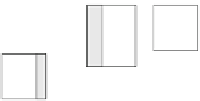Information Technology Reference
In-Depth Information
Fig. 7.8
Symbol for
reversible carry generation
Table 7.1
Binary addition example
(1 1 1)
111
+111
1110
Fig. 7.9
Reversible adder for two 3-bit numbers
input bits are c
in0
, which is the carry into the operation, and the operands a, b.
The carry may be generated as in Fig.
7.8
.
For example, if c
in0
is zero, while a, b are 1, 1, the inputs on the left are
0
,
1
,
1
,
0
.
The carry out is c
1
¼
1. It can be verified by
tracing from left to right that the outputs on the right are
0
,
1
,
1
,
1
as required.
1 since 0 + 1 + 1 equals 0 with c
1
¼
Multiple Bit Numbers
Here is an example of adding two unsigned numbers each with three bits. Shown in
Table
7.1
is an addend of 7 being added to an augend of 7, or in binary 111 + 111.
The carries into the next places are in parenthesis. These numbers correspond to
adding 7 to 7 and arriving at a sum of 14, that is, binary 1110. Figure
7.9
shows how
such addition may be done reversibly.
Operations are executed one at a time, from left to right. First the carries are
generated; sums are then calculated beginning in the most significant place. The
zero inputs to each carry block are “scratchpad” lines for the calculation. As
the sums are computed, the carry programming is reversed to restore the scratchpad
lines back to zero. Interested readers can trace the result of adding 7 + 7. Let
C
in0
¼
0; A0, A1, A2
¼
1, 1, 1; B0, B1, B2
¼
1, 1, 1. The result obtained in this
test case is C
3
, S
2
, S
1
, S
0
¼
1, 1, 1, 0.
































































































































Search WWH ::

Custom Search